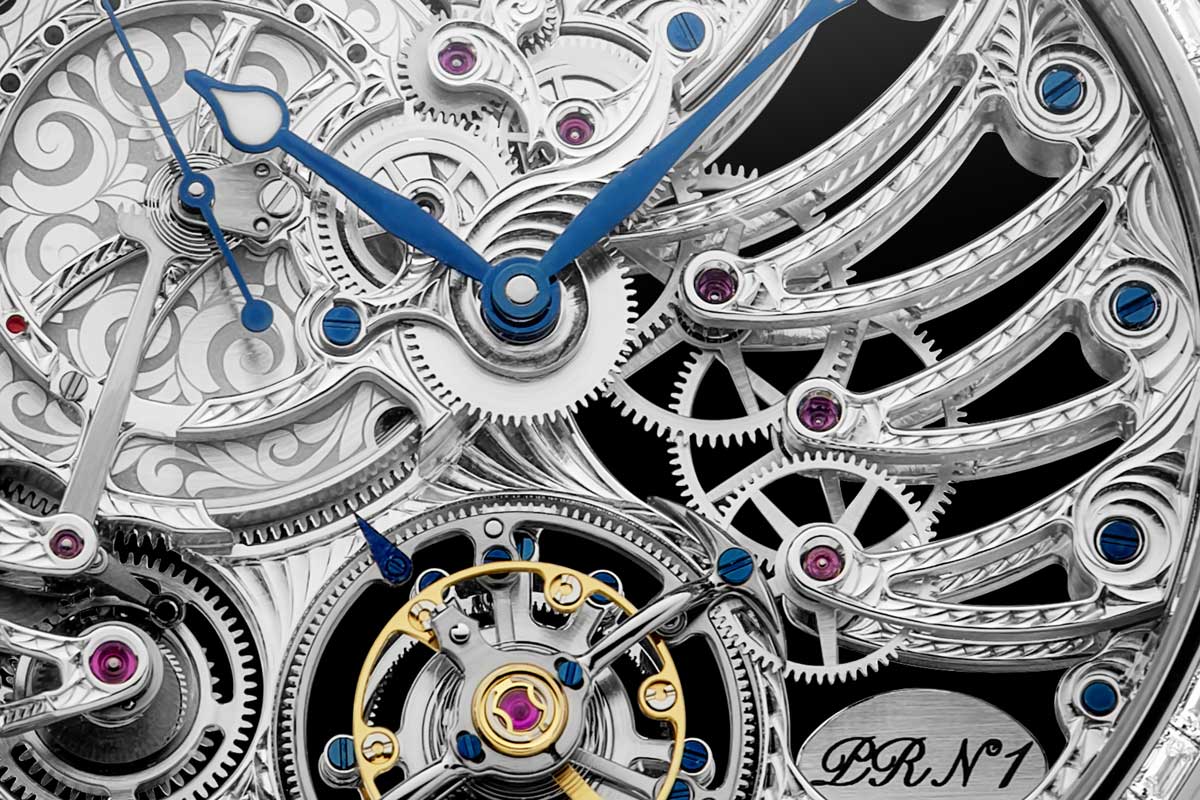Signature BOVET Fleurier case with the bow at 12 o’clock
Patented spherical rewinding system
10-Day power reserve with a single barrel


Every plate, bridge and other surface fully hand-engraved on both sides
Patented double-sided flying tourbillon
80+ hours to engrave the movement and trademarked Writing Slope case
Overview
It stands to reason that skeletonized timepieces particularly appeal, for they put all the mechanical complexity on full display. In the 22 years since Mr. Pascal Raffy took the helm of BOVET, he has insisted on making sure the movement is visible, its high watchmaking pedigree open to be admired, while at the same time reinforcing the House’s commitment to the decorative arts.
Given this focus on mechanical artistry, it might seem a bit surprising that the new Virtuoso XI is the very first full skeleton timepiece the House has ever introduced.
And what a skeleton it is.
Design

Features & Functionality
The delicate dance when skeletonizing a movement is to remove enough material to enhance the aesthetics and completely show the inner workings, while still keeping the movement robust enough to function impeccably. Take away too much material from the bridges, for example, and they could deform and damage the performance of the movement.

Click the image to try the loupe

Click the image to try the loupe
With the Virtuoso XI, the movement was specifically conceived and designed from the start to have enough space to engrave both sides of the bridges and plates, and room to admire them, and the result is exceptional. More transparent than any timepiece that BOVET has ever produced, every aspect of this high watchmaking movement is on full display.
The hand-engraving for the Virtuoso XI takes around 60 hours for the movement and the Writing Slope case. The engraving is done free-hand and leaves no room for mistakes. Surprisingly, the engravers, sitting quietly in the well-lit atelier, don’t seem to feel any pressure, though anyone watching them certainly does. The artisans delight in the dance of their tools as they transform a plain bridge or plate into an engraved objet d’art.
The decoration is BOVET’s own Fleurisanne motif, one that the House has used for decades. Inspired by the tree leaf pattern on Greek columns from centuries ago, this theme is one of the signatures of BOVET. The name of this motif recalls that the House is still based a stone’s throw from where it was founded – a small village named Fleurier.

Click the image to try the loupe

Click the image to try the loupe
The flying tourbillon movement that drives this exceptional timepiece meets BOVET’s demanding criteria of chronometry, reliability, and expression. It draws its energy from a single barrel that ensures more than 10 days of power reserve (240 hours, when the industry standard is 42-48 hours), all while maintaining the balance wheel’s oscillations at 18,000 vph.
Finally, the long power reserve, provided by a single barrel, would require meticulous winding if not for the spherical differential winding system. The application of this ingenious mechanism, and the multi-gear three-dimensional teeth of one of its pinions, has received two patents. Because of this system, the number of crown turns needed for full winding of the mainspring is halved without increasing friction and forces exerted on the gears.

Click the image to try the loupe


It stands to reason that skeletonized timepieces particularly appeal, for they put all the mechanical complexity on full display. In the 22 years since Mr. Pascal Raffy took the helm of BOVET, he has insisted on making sure the movement is visible, its high watchmaking pedigree open to be admired, while at the same time reinforcing the House’s commitment to the decorative arts.
Given this focus on mechanical artistry, it might seem a bit surprising that the new Virtuoso XI is the very first full skeleton timepiece the House has ever introduced.
And what a skeleton it is.
Signature BOVET Fleurier case with the bow at 12 o’clock
Patented spherical rewinding system
10-Day power reserve with a single barrel
Every plate, bridge and other surface fully hand-engraved on both sides
Patented double-sided flying tourbillon
80+ hours to engrave the movement and trademarked Writing Slope case
Features & Functionality
For this reason, the Virtuoso XI flying tourbillon movement, first used in the Virtuoso VIII (2017), already endowed with beautiful and finely finished details, was re-engineered specifically to be open worked. The original movement’s Grand Date was removed and the gear train relocated to a more aesthetic position, and the entire movement was designed to be skeletonized. The bridges and plates were made as thin as possible from the start, and where they couldn’t be made any thinner due to structural requirements, angling and beveling makes them appear thinner than they actually are.

The decoration is BOVET’s own Fleurisanne motif, one that the House has used for decades. Inspired by the tree leaf pattern on Greek columns from centuries ago, this theme is one of the signatures of BOVET. The name of this motif recalls that the House is still based a stone’s throw from where it was founded – a small village named Fleurier.
The power reserve barrel is laser-engraved with the Fleurisanne pattern. Due to the barrel’s thin metal, hand-engraving was impossible, as the metal would have deformed under the engraver’s pressure.
The Virtuoso XI’s movement uses BOVET’s patented double-side flying tourbillon, and the hair spring and regulating organ used are entirely made in-house.


